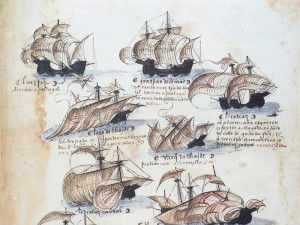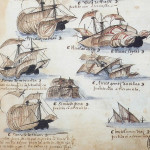This post is also available in:
![]() Français
Français
Written by Marco Ramerini. English text revision by Dietrich Köster.
The big island of Madagascar was discovered in 1500 by a Portuguese fleet under the command of Diogo Dias, which was part of a fleet of 13 ships commanded by Pedro Álvares Cabral. The Portuguese called the new discovered island Ilha de São Lourenço.
The island was visited several times during the XVIth and XVIIth centuries, but they were never permanently settled. A lot of shipwrecks were scattered along its coast.
In the year 1613 the Viceroy Dom Jerónimo de Azevedo sent a Portuguese expedition to explore the shores of the island. This expedition discovered that “gente branca” (white people) had lived at a place on the southern side of the island. These white people had settled on a river island, they had called the island of Santa Cruz (Ilha de Santa Cruz) in the Fanjahira river, which became known as “Tranovato” (House of stone).
The Portuguese expedition visited this place. On the island a stone tower or a fort with two doors was found. At that time there was also a fine marble “padrão” with a front and a reverse side. On one side was carved the coat of arms of Portugal with the following words underneath: REX PORTUGALENSIS. On the other side the Holy Cross was carved and close to the padrão there was a stone cross on the ground. The expedition also found three graves with crosses.
It is speculated that this settlement was built by Portuguese at the beginning of the XVIth century (1505 ? 1527 ?), who might have had survived a shipwreck. A chronicler of the XVIIth century referred to a local population, who massacred these Portuguese, having settled this place. The chronicler also stated that in his own time (1600) there were many mestiços born from a crossbreed between the shipwrecked people and the local inhabitants.
Still today in the XX century, near Tolanaro or Fort Dauphin on an island at the mouth of the Vinanibe River the remains of this settlement are to be seen. The fort is square-shaped and it is a very important historical witness, because it is the first European building erected on the island of Madagascar.
- Part of the fleet commanded by Pedro Álvares Cabral, the navigator who discovered Brazil in 1500.
- Part of the fleet commanded by Pedro Álvares Cabral, the navigator who discovered Brazil in 1500.
BIBLIOGRAPHY:
– Canitrot. (1921). Les Portugais sur la côte orientale de Madagascar et en Anosy au XVIe siècle (1500-1613-1617). Revue Francaise d’Histoire d’Outre Mer, 04-06, 203–238.
– Leitão, Humberto “Os dois descobrimentos da Ilha de São Lourenço, mandados fazer pelo Vicerei D. Jerónimo de Azevedo nos anos de 1613 a 1616” 431 pp., maps, Centro de Estudos Históricos Ultramarinos, 1970, Lisbon, Portugal. Index: Diário da viagem da Caravela “Nossa Senhora da Esperança” (1613-1614), relação da jornada e descobrimento da Ilha de São Lourenço, relação do segundo descobrimento no ano de 1616, roteiro da Ilha de São Lourenço.
– Linon-Chipon, Sophie. (2005). La Poétique des stèles. Du padrao portugais d’Anosy (1508) au frontispice rodriguais de Legaut. (In: Rivalités maritimes européennes: XVIe-XIXe siècles) Revue d’Histoire Maritime, 4-2005, 51–70.
– Pearson, Mike P. (1997). Close encounters of the worst kind: Malagasy resistance and colonial disasters in southern Madagascar. World Archaeology, 28(3), 393–417.
– Pier M. Larson “Colonies Lost: God, Hunger, and Conflict in Anosy (Madagascar) to 1674” in Comparative Studies of South Asia, Africa and the Middle East (2007) 27(2): 345-366.
– Oliver, P. (1902, Feb). A Jesuit Mission to Madagascar in 1613-14, The Month: A Catholic Magazine, 99(2), 171-182.
– Pierre Vérin, Claude Allibert, Narivelo Rajaonarimanana. “La tranovato de l’Anosy, première construction érigée par des Européens à Madagascar. Description et problèmes” Tananarive, Taloha 6, 1974, p. 117-142
– H.T. Wright, J.A. Rakotoarisoa, G. Heurtbize, P. Verin “The evolution of settlement systems in the Efaho River Valley, Anosy (Madagascar)” Bulletin of the Indo-Pacific Prehistory Association 12-13 1994 p. 61-93
This post is also available in:
![]() Français
Français
 Colonial Voyage The website dedicated to the Colonial History
Colonial Voyage The website dedicated to the Colonial History





































































